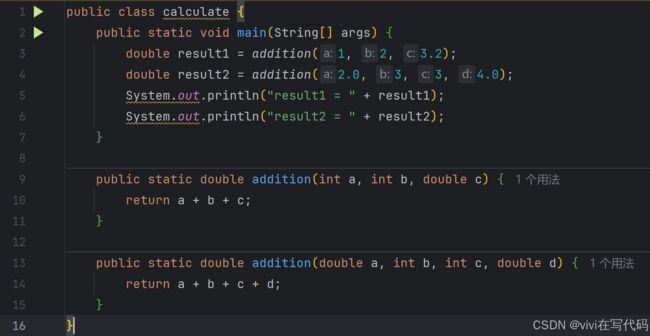Java 类与对象和类的继承
一、类与对象
1.1 类和对象的概念
面向对象程序设计将程序看做是一系列对象组成,而不是一系列动作组成。
-
对象(实例):一个包含状态(数据)和行为(方法)的编程实体,是具体的。
-
类:具有相同特征的事物的抽象描述,是抽象的。
-
一个类里可以有多个对象
1.2 类的成员
- 属性(特征)
该类事物的状态信息。对应类中的成员变量
格式:访问修饰符 数据类型 属性名
例: public String name;
private int score;
- 方法(函数)
该类事物的行为。对应类中的成员方法。
格式:public 方法名(参数类型 参数名, ,){
}
public void printSum ( int n, int m){
int sum = n + m;
System.out.println("sum = " + sum);
}
类的定义示例代码:
public class Student {
//成员变量
private String name;
private int age;
//成员方法
public void study() {
this.age = 18;
this.name = "Peter";
System.out.println("student name is " + s.name);
System.out.println("student age is " + s.age);
}
1.3 构造方法
- 两种构造方法:无参构造方法,有参构造方法;
- 在对象的生命周期中只调用一次;
- 名字与类名相同;
- 无返回值;
- 每个类都有一个默认的无参构造函数。
在用户没有定义有参构造方法时,new对象时会自动调用无参构造方法;在定义有参构造方法后,默认的无参构造方法就会被替代; - 构造方法的作用:
(1)创建对象
(2)同时给多个属性初始化
格式:
public 类名(){ 方法体... }
public 类名(参数类型 参数名, ,){ 方法体... }
public class Fruit {
private String name;
private String taste;
private String color;
//有参构造函数
public Fruit(String name, String taste, String color) {
this.name = name;
this.taste = taste;
this.color = color;
}
//无参构造函数
public Fruit() {
this("Fruit", "Red", "Blue");
}
1.4方法重载
方法重载: 同一个方法通过参数选择实现不同的功能
格式:
1.方法名相同;
2.参数列表不同:参数类型,个数,顺序不同;
注意:返回值类型和访问修饰符不同,其他相同时不算重载;
示例:
输出结果:

二、类的继承
2.1 什么是继承?
继承是类与类之间的一种关系
继承是对原来类(父类)功能的扩展,并创建新的类(子类)
2.2 继承的特点
- java中类是单继承,Java中一个类可以实现多个接口,接口是多继承;
- 一个子类只能有一个父类,但一个父类可以有多个子类;
- 支持多层次继承:
子类的子类 -> 子类 -> 父类 -> 父类的父类; - 子类会继承父类中所有的属性和方法,但私有属性不能直接使用;
2.3 继承的格式
public class 子类(派生类) extends 父类(基类,超类)
**其中extends是关键字**
下面是示例代码:
父类的定义 示例:
public class Fruit {
private String name;
private String taste;
private String color;
public void show(){
System.out.println("Fruit Name: " + name);
System.out.println("Fruit Taste: " + taste);
System.out.println("Fruit Color: " + color);
}
子类的定义 示例:
public class apple extends Fruit {
//apple是Fruit的子类,继承关键字是extends
public void print() {
System.out.println(getName()+" is picked.");
}
public void show() {
//保留父类原来的功能
super.show();
//新增功能
System.out.println("Apple is fruit");
}
}
2.4构造方法的调用
- 在子类中一定要调用父类中的一些构造函数;父类中的无参构造函数会被默认调用;
- 父类中的无参构造函数会被默认调用;
- 手动调用父类中的构造方法:super(参数);
2.5方法重写
当父类中的方法不能满足当前子类的需求时,需要重写方法;
重写格式:
- 在有继承关系的的两个类之间
- 方法名、返回值和类型参数列表(个数,顺序)相同;
- 子类重写方法的访问修饰符 >= 父类原来方法的访问修饰符
public > protect > 缺省 > private
若要保留父类原有的功能:调用父类方法
用super表示当前类的父类对象
public void show() {
super.show();
System.out.println("Apple is fruit");
}